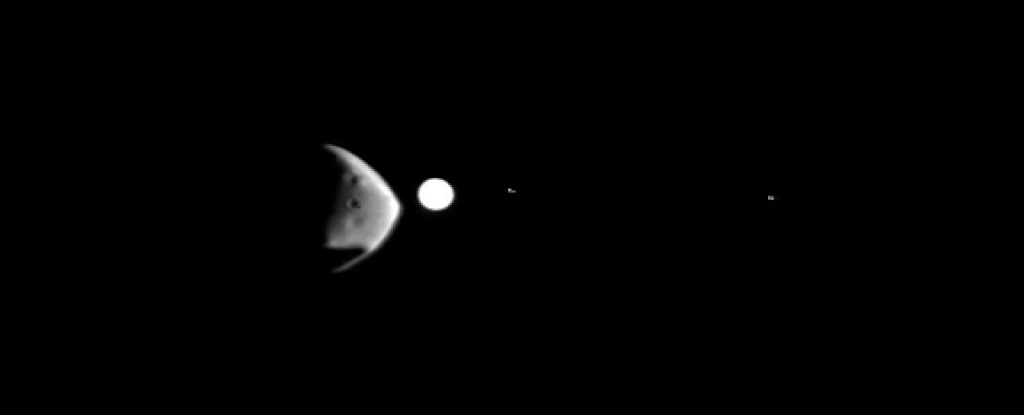Every hour of the day, every day of the year, our Solar System is just out there beyond Earth's pale blue sky, doing its thing. Sometimes – if we're in the right place at the right time – we get to see that thing from a new perspective.
A little spacecraft over 100 million kilometers (62 million miles) from home happened to be in the right place at the right time, and we couldn't be more grateful.
Going about its business monitoring the red planet, the European Space Agency's Mars Express probe recently caught an eclipse involving the smaller Martian moon, Deimos, and Jupiter with its four Galilean moons.
At the time around 745 million kilometers separated Mars from its giant planetary neighbour, but for a few brief moments Deimos and and the Jovian system looked like one happy family.
On 14 February 2022, the alignment of these astronomical bodies was caught on camera, in a series of 80 images that was then stitched together into a movie.
"Such an alignment," ESA wrote in a statement, "is extremely unusual because Deimos must be exactly in the orbital plane of Jupiter's moons for the alignment to occur."

The video shows Deimos, which is just 15 kilometers long, slowly moving across the screen from left to right. As it passes, it occults ice moon Europa and giant moon Ganymede, which appear as small, star-like dots; then the disk of Jupiter; followed by the volcanic moon Io; and finally Callisto, the second-largest of Jupiter's moons.
These observations allowed Mars scientists to more accurately measure the position and orbit of Deimos, which is hard to do from Earth, since the Martian moons are so small and dim. Understanding their orbits may be key to understanding where they came from. It's unclear whether Deimos and the larger of the two moons, Phobos, were once part of a larger body that broke apart, or a passing asteroid that was captured by Mars' gravity.
Better characterization of their orbits will allow scientists to better model what's going to happen to Mars' moons in the future, too. Phobos is currently moving slowly towards Mars; scientists think within the next 100 million years it will be so close to Mars its gravity will tear the moon to smithereens, resulting in a temporary Phobos ring around the planet.
Deimos, on the other hand, is slowly moving away from Mars. If it continues in this trend, then scientists think that it will eventually escape Mars' gravitational hold and make its own way in the big wide Solar System.
Nothing lasts forever. Not even the relationship between a planet and its moons.
